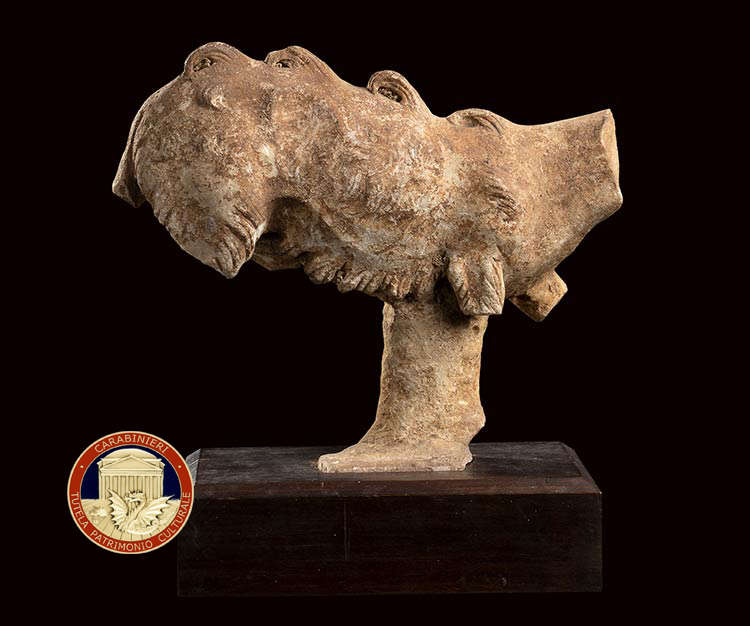Important recovery for the Carabinieri of the Nucleo Tutela Patrimonio Culturale of Monza , who bring back to Italy some goods stolen by German occupation troops during World War II. In the course of the usual checks of e-commerce platforms and sites specializing in the sale of works of art, the Carabinieri of Monza in fact identified numerous artifacts of an archaeological nature presented as coming from the Pietro Fedele collection and formerly stored at the Tower of Pandolfo di Capodiferro, an ancient 10th-century Longobard coastal tower located in Sessa Aurunca (Caserta) and razed to the ground in 1943 by the Germans, who, before destroying it, nevertheless looted it. Initial investigations ascertained that these artifacts were of state-owned provenance and had already been musealized in what was known as the Museum of Aurunca Civilization, founded in 1926 by then Minister of National Education Pietro Fedele, inside the Tower.
In collaboration with officials from the Soprintendenza Archeologia, Belle Arti e Paesaggio and staff from the Central Institute for Restoration, the Carabinieri were able to reconstruct the events that saw the very Tower of Pandolfo di Capodiferro destroyed and before that looted. A fate common to other cities and places of culture such as Milan, Montecassino, but also Pompeii and the Bourbon Real Ferdinando Bridge that surmounts the Garigliano River place where the Germans had set off the well-known “Gustav Line.” Jewels of our cultural heritage that suffered the wartime consequences of World War II. Pandolfo Capodiferro’s tower was granted in the 1920s in emphyteusis to Pietro Fedele by the Municipality of Sessa Aurunca, owner of the property and the surrounding state-owned area, at his request to set up an archaeological museum, for an annual rent of 200 liras and with the obligation to restore it. The fee was later reduced to one lira “...as a tangible sign of recognition and gratitude...for the reconstruction of the Longobard Tower...”. In 1926 Pietro Fedele was so passionate about the management of the Tower as a vestige of his own cultural identity that he had it included in the family coat of arms despite the fact that the property was state-owned.

 Material recovered by the
Material recovered by the Material recovered by the
Material recovered by the Material recovered by the
Material recovered by theThe museum occupied all four floors of the tower displaying numerous archaeological, numismatic and other artifacts belonging to the Middle Ages. Hundreds of gold, silver and even ivory pieces were joined by Jacopo del Conte’s portrait of Giulia Gonzaga, ancient prints representing views of the territory of Minturno, Gaeta, Fondi and Formia without forgetting the corner dedicated to Maria Cristina of Savoy and the approximately 8,000 volumes kept in the library. The meticulously conducted investigation made it possible to reconstruct the journey these goods traveled over time. The loot from the razing carried out in the fall of 1943 when German troops of the 15th Panzer Grand Division I.C. entered (on behalf of the Kunstschutz) and looted the museum, was carefully sorted by the soldiers and collected in numerous crates. Some of the material was later returned through the State Archives of Rome Sant’Ivo and Castel Sant’Angelo, places where the goods were deposited during the war, to the heirs of Pietro Fedele.
At the end of the war, the dispersed assets were the subject of a specific investigation conducted by the then Minister Plenipotentiary Rodolfo Siviero, who headed the Restitution Committee; an activity subsequently sealed by the publication in 1995 of the volume “L’opera da ritrovare. Repertoire of the Italian heritage dispersed at the time of World War II.”
To date, additional archaeological artifacts, coins, medals and various materials attributable to the institutional activity carried out by the then Minister of Education, Pietro Fedele, are missing from the roll call. As stated by experts in the field, the destruction of the tower was a very serious loss for culture and the region. For this reason, the restitution by the Carabinieri Tutela Patrimonio Culturale acquires inestimable value because it restores the true value to these cultural assets which, as stated in Article 2 of the “Code of Cultural Heritage and Landscape”, are objects that represent testimony having the value of civilization and every time someone considers these goods only as objects to be sold by removing them from their historical context and origins, he erases their cultural heritage that is, their true value thus impoverishing all of us.
 |
| Carabinieri recover goods stolen by Germans from Sessa Aurunca Museum during the war |
Warning: the translation into English of the original Italian article was created using automatic tools. We undertake to review all articles, but we do not guarantee the total absence of inaccuracies in the translation due to the program. You can find the original by clicking on the ITA button. If you find any mistake,please contact us.